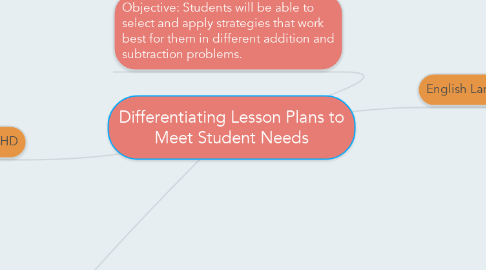
1. ADHD
1.1. Interest
1.1.1. Technology
1.1.2. Math
1.1.3. Reading
1.1.4. PE
1.2. Readiness to Learn
1.2.1. Wants to learn, but behavior can be a problem.
1.3. Teaching Strategies
1.3.1. Allow standing during instruction time and give breaks often.
1.3.1.1. When the student has been working for awhile, and the teacher starts to notice he/she is not being able to focus any longer, allow for a break in a sensory area outside the classroom, or a walk around the floor with the assistant teacher, or go to the playground for a 5 minute break with the assistant teacher. This allows for the student to refocus when coming back into the classroom.
1.3.2. Sensory tools
1.3.2.1. Let the student squeeze a rubber ball and have a weighted vest/pillow. This allows them to focus on the teacher.
1.3.3. Keep instruction time short, direct, and simple
1.3.3.1. Telling the student what to do exactly and what the expectation is, helps the student learn and be successful in that task/activity.
1.3.3.1.1. Keep instructions posted on the smartboard
1.3.4. Make colorful charts/drawings, props, use technology.
1.3.4.1. This draws the student into the lesson and helps keep the student attention.
2. Objective: Students will be able to select and apply strategies that work best for them in different addition and subtraction problems.
3. References: Effective Teaching Strategies for English Language Learners: http://www.supportrealteachers.org/strategies-for-english-language-learners.html
4. English Language Learners
4.1. Interest
4.1.1. Technology
4.1.2. Science
4.1.3. PE
4.1.4. Social Studies
4.2. Readiness to Learn
4.2.1. Wants to learn, always participating in classroom discussions.
4.3. Teaching Strategies
4.3.1. Teach vocabulary when talking to the student directly
4.3.1.1. Teach what certain math vocabulary is. Don't assume everyone knows it. Example: if students need to write a number model, show students what number model looks like. Another term they might know is a number sentence.
4.3.1.1.1. Explaining math vocabulary can clear up any misunderstanding and can keep the ELL student attention.
4.3.2. Have the student restate instructions (privately) to the teacher, so the teacher knows this student understands what he/she is suppose to do.
4.3.2.1. If students are going to be playing a math game with a partner, ask the student how to play the game before sending them off with their partner.
4.3.2.1.1. To make sure an ELL student know the objective of the math game before they play with an partner will allow for both the partner and ELL student success, and eliminates any embarrassment for the ELL student if they had an uncertainly about the game.
4.3.3. Teacher gives one on one instructions.
4.3.3.1. There are several word problems posted on google classroom, students are suppose to answer these word problems on their iPad, showing a number model, picture model, and words. To make sure the student knows the 3 ways they are suppose to show their thinking, the teacher can tell him/her directly and then show tell him/her to raise their hand when they are done so the teacher and student can upload their work together.
4.3.3.1.1. Giving direct one on one instructions and checking back in and continuing the support to help show the next steps will allow for a higher success rate for an ELL student.
4.3.4. Use as many ways to convey informations (oral, written, videos, teaching demonstrations, student demonstrations.
4.3.4.1. When teaching different strategies, make classroom charts to keep up, use videos (BrainPOP Jr.) and model out examples.
4.3.4.1.1. This way ELL students are able to see a strategies presented in many ways, also using technology, which the students are interested in.
